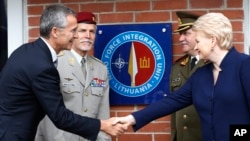Fighter jets roaring overhead, NATO on Thursday inaugurated a military center in the Lithuanian capital amid growing concerns in the Baltic countries over Russia's military presence.
NATO Secretary-General Jens Stoltenberg, who joined Lithuanian President Dalia Grybauskaite for the opening ceremony, described the new unit as a “big step forward toward greater solidarity, greater strength and greater readiness.”
The NATO force integration unit in Vilnius is one of six small headquarters - manned by some 40 staff each — that opened this month in Bulgaria, Estonia, Latvia, Poland and Romania, as part of the alliance's biggest reinforcement of collective defense since the end of the Cold War.
Grybauskaite welcomed the new units, saying they would ensure the quick and effective movement of troops. “And they help send a very clear message — no NATO ally stands alone,” she said, pointing to Russian aggression in Ukraine as threatening the security of Europe. “This is why we have decided to bolster our security.”
Suspicious of Moscow’s intentions
Lithuania and its Baltic neighbors, Latvia and Estonia, were occupied for nearly five decades by the Soviet Union. After regaining independence in 1991 they joined the European Union and NATO in 2004, but continue to be suspicious of Moscow's intentions.
Earlier this year, Lithuania distributed wartime survival manuals to schools across the country - a 98-page booklet with advice from building basement shelters to handling hostage dramas and evacuating from fighting zones. It also organized survival camps for families, teaching them to shoot and how to survive in war zones and threatening situations.
In February, the government restored compulsory military service for men aged 19 to 27, but is reconsidering the measure after a flood of applications from volunteers wanting to serve in the armed forces, expected to reach 3,000 by the end of the year.
Drilling at a parade ground in the coastal city of Klaipeda, Junior Pvt. Saulius Sirvinskas learns how to disassemble, clean and repair his rifle until it becomes second nature. “I love my country and it's like I'm returning the favor to my country by serving this military duty,” he said.
‘Showing our readiness’
Lithuanian Defense Minister Juozas Olekas recalled the events in Hungary and Czechoslovakia during the Soviet era and said that similar aggression in Ukraine now should be met by “showing our readiness” to act.
“This is the only answer which can be understood by Russian President [Vladimir] Putin,” he said in an interview with The Associated Press earlier this week.
Although Moscow has made no moves against its small Baltic neighbors, which all have sizeable Russian-speaking minorities, they are worried about its increased military presence in the vicinity of the outpost of Kaliningrad, partly a Russian military base, sandwiched between Lithuania and Poland.
NATO, which patrols the airspace of the three Baltic allies, has reported more than 400 intercepts by NATO fighter jets of Russian military aircraft flying near the borders of the Baltic countries last year, an increase of 50 percent over 2013.
NATO Opens Military Center in Lithuania Amid Ukraine Crisis

VILNIUS —







